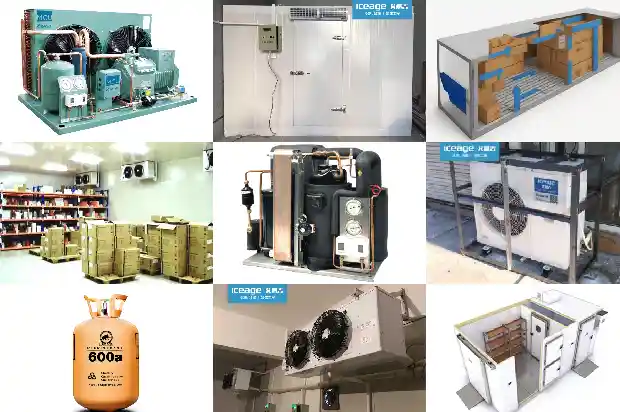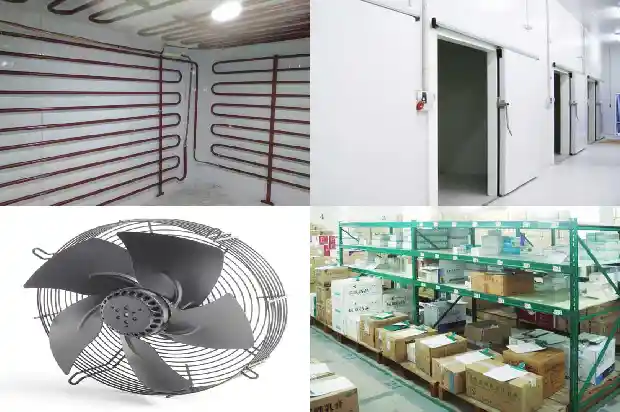10 Symptoms and Causes of Abnormal Frosting in Heat Pumps
2024-12-27
Frost formation and defrosting of air - source heat pumps are normal phenomena. The units are equipped with an automatic defrosting function to ensure normal heating and hot water supply for users. In the currently mainstream defrosting methods, during the entire defrosting process, there is no need to stop the compressor or switch the four - way valve. The indoor unit will not blow cold air, which has little impact on the indoor temperature, provides good comfort, and users can rest assured!
However, there are also some situations that lead to abnormal frost formation of the unit, which is the main cause of heat pump operation failures. Abnormal frost and ice formation on the unit are just the surface symptoms of the unit "malfunctioning". Different frost symptoms have different pathologies, and different causes result in different shapes and forms of frost.
Frost symptom 1: Ice formation at the bottom
Cause: Poor water flow in the drain pan, and the ice spreads to the evaporator.
Solution: Remove the ice, clean the dirt, and ensure the water outlet is unobstructed.
Cause: Poor water flow in the drain pan, and the ice spreads to the evaporator.
Solution: Remove the ice, clean the dirt, and ensure the water outlet is unobstructed.
Frost symptom 2: Local ice formation on the evaporator
Cause: No frost at the defrost sensor, and incorrect defrosting point.
Solution: Manually force defrosting, and move the defrost sensor to the ice - or frost - covered area.
Cause: No frost at the defrost sensor, and incorrect defrosting point.
Solution: Manually force defrosting, and move the defrost sensor to the ice - or frost - covered area.
Frost symptom 3: The evaporator is fully covered with frost/ice and does not defrost
Cause 1: Malfunction of the defrost sensor or ambient temperature sensor.
Solution: Manually force defrosting. If there is resistance drift, replace the sensor.
Cause 2: Lack of refrigerant or system blockage.
Solution 2: Add refrigerant according to the standard and remove the blockage by welding.
Cause 3: The defrosting and four - way reversing valve do not reverse; the solenoid valve of the bypass defrosting system does not operate.
Solution 3: Check if the valve is energized and whether it operates normally.
Cause 1: Malfunction of the defrost sensor or ambient temperature sensor.
Solution: Manually force defrosting. If there is resistance drift, replace the sensor.
Cause 2: Lack of refrigerant or system blockage.
Solution 2: Add refrigerant according to the standard and remove the blockage by welding.
Cause 3: The defrosting and four - way reversing valve do not reverse; the solenoid valve of the bypass defrosting system does not operate.
Solution 3: Check if the valve is energized and whether it operates normally.
Frost symptom 4: Incomplete defrosting
Cause 1: The set temperature of the defrost - exiting coil is too low, causing the defrosting to end before the frost is completely melted.
Solution 1: Adjust the defrosting parameters, increase the defrost - exiting temperature, and observe until the defrosting is complete.
Cause 2: The placement position of the defrost coil probe is inappropriate, not in the area with the most severe frost.
Solution 2: Adjust the position of the defrost probe and place it in the area with the most severe frost.
Cause 1: The set temperature of the defrost - exiting coil is too low, causing the defrosting to end before the frost is completely melted.
Solution 1: Adjust the defrosting parameters, increase the defrost - exiting temperature, and observe until the defrosting is complete.
Cause 2: The placement position of the defrost coil probe is inappropriate, not in the area with the most severe frost.
Solution 2: Adjust the position of the defrost probe and place it in the area with the most severe frost.
Frost symptom 5: Frequent frost formation in a short time
Cause 1: The finned heat exchanger is dirty and blocked or there are foreign objects blocking it.
Solution 1: Clean the heat exchanger or remove the foreign objects.
Cause 2: The fan motor is damaged or the fan air volume is too small.
Solution 2: Repair or replace the motor or replace it with a fan with a larger air volume.
Cause 3: The refrigerant charge amount is too small.
Solution 3: Add refrigerant to the appropriate pressure.
Cause 4: The opening of the throttling expansion valve is too small.
Solution 4: Increase the opening of the expansion valve.
Cause 5: The area of the finned heat exchanger is too small.
Solution 5: Request the manufacturer to replace the finned heat exchanger to increase the area.
Cause 1: The finned heat exchanger is dirty and blocked or there are foreign objects blocking it.
Solution 1: Clean the heat exchanger or remove the foreign objects.
Cause 2: The fan motor is damaged or the fan air volume is too small.
Solution 2: Repair or replace the motor or replace it with a fan with a larger air volume.
Cause 3: The refrigerant charge amount is too small.
Solution 3: Add refrigerant to the appropriate pressure.
Cause 4: The opening of the throttling expansion valve is too small.
Solution 4: Increase the opening of the expansion valve.
Cause 5: The area of the finned heat exchanger is too small.
Solution 5: Request the manufacturer to replace the finned heat exchanger to increase the area.
Frost symptom 6: Severe frost formation, with all fins covered with a thick layer of frost
Cause 1: The set temperature of the defrost - entering coil is too low, or the defrosting interval is set too long, resulting in failure to enter the defrosting operation in time.
Solution 1: Adjust the defrosting parameters, increase the defrost - entering temperature, shorten the interval, and observe until the defrosting operation can be entered in time.
Cause 2: The placement position of the defrost coil probe is inappropriate, not in the area with the most severe frost.
Solution 2: Adjust the position of the defrost probe and place it in the area with the most severe frost.
Cause 1: The set temperature of the defrost - entering coil is too low, or the defrosting interval is set too long, resulting in failure to enter the defrosting operation in time.
Solution 1: Adjust the defrosting parameters, increase the defrost - entering temperature, shorten the interval, and observe until the defrosting operation can be entered in time.
Cause 2: The placement position of the defrost coil probe is inappropriate, not in the area with the most severe frost.
Solution 2: Adjust the position of the defrost probe and place it in the area with the most severe frost.
Frost symptom 7: Uneven frost formation, with thick frost in some areas and no frost in others
Cause 1: Uneven refrigerant distribution, with large flow in some pipelines and small flow in others.
Solution 1: Request the manufacturer to adjust the structure of the refrigerant distributor to match the flow rate with the evaporation capacity.
Cause 2: Unreasonable structural design, such as the finned heat exchanger being too high, resulting in a large difference in the face - on wind speed between the upper and lower parts.
Solution 2: Request the manufacturer not to make the heat exchanger too high or increase the fan air volume.
Cause 1: Uneven refrigerant distribution, with large flow in some pipelines and small flow in others.

Solution 1: Request the manufacturer to adjust the structure of the refrigerant distributor to match the flow rate with the evaporation capacity.
Cause 2: Unreasonable structural design, such as the finned heat exchanger being too high, resulting in a large difference in the face - on wind speed between the upper and lower parts.
Solution 2: Request the manufacturer not to make the heat exchanger too high or increase the fan air volume.
Frost symptom 8: Low - pressure protection during defrosting
Cause 1: No delay or too short a delay is set for low - pressure detection during defrosting.
Solution 1: A delay should be set for low - pressure protection during defrosting or the delay time should be extended.
Cause 2: The throttling expansion valve is blocked or has a too - small opening in the reverse direction.
Solution 2: Replace the expansion valve or increase the opening of the expansion valve.
Cause 1: No delay or too short a delay is set for low - pressure detection during defrosting.
Solution 1: A delay should be set for low - pressure protection during defrosting or the delay time should be extended.
Cause 2: The throttling expansion valve is blocked or has a too - small opening in the reverse direction.
Solution 2: Replace the expansion valve or increase the opening of the expansion valve.
Frost symptom 9: High - pressure protection during defrosting
Cause: The set temperature of the defrost - exiting coil is too high, causing the high - pressure protection to occur without ending the defrosting.
Solution: Adjust the defrosting parameters, lower the defrost - exiting temperature, and observe until the defrosting is complete.
Cause: The set temperature of the defrost - exiting coil is too high, causing the high - pressure protection to occur without ending the defrosting.

Solution: Adjust the defrosting parameters, lower the defrost - exiting temperature, and observe until the defrosting is complete.
Frost symptom 10: Defrosting operation occurs even when there is no frost on the fins
Cause: The set temperature (or temperature difference) of the defrost - entering coil is too high, resulting in a false operation.
Solution: Adjust the defrosting parameters, increase the defrost - entering temperature (or temperature difference), and observe until the fins are frosted to an appropriate degree before defrosting.
Cause: The set temperature (or temperature difference) of the defrost - entering coil is too high, resulting in a false operation.
Solution: Adjust the defrosting parameters, increase the defrost - entering temperature (or temperature difference), and observe until the fins are frosted to an appropriate degree before defrosting.
Related Articles
- What Are the Common Causes of Cold Air Blower Noise?
- Air - conditioner Low - pressure Alarm? These Nine Common Causes
- What Are the Causes of Scroll Compressor Damage?
- Causes and Prevention of "Primary Condensation" and "Secondary Condensation" in Fan - Coil Units
- Common Causes and Analysis of High and Low Pressure Alarms
- Common Causes and Analysis of Compressor Thermal Protection
- 4 Points on Causes of Water Leakage in Closed Cooling Towers
- Analysis of Causes for Safety Valve Leakage
- What Causes Noise in Pressure Reducing Valves?
- Causes and Solutions for Elevated Pressure in Cold Storage
- Common Causes of Frost Build-up in refrigerant evaporators
- What Causes Poor Refrigeration Effect of Refrigerated Trucks?
- Common Causes of Air Conditioner Compressor Failures
- Reasons for Frost Formation in Cold Storage and Defrosting Methods
- Frosting and Defrosting Issues of Air - cooled Heat Pumps
- Fin Spacing Design of Cooler and Several Knowledge Points of Defrosting in Cold Storage
- Defrosting Operation Modes of Refrigeration Equipment and Its Control Components
- Essential for Maintenance! Parameters and Phenomena of Normal Operation of Refrigeration and Heating Systems
